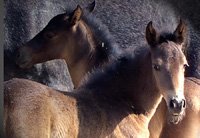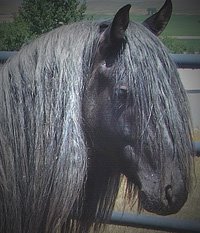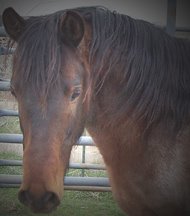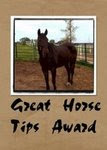At this time last week, I was high on a forested mountain trail, grinning and still holding Consolation in as she sped toward the first water stop on the first loop of the 50 mile race at Old
Selam. She had her wits about her, but she was moving out, and I was in love.
We'd driven to
ridecamp the day before -- just the two of us, alas, because
Ironman had to work -- and selected an easy parking spot at the far end of camp. I spent the early afternoon setting up my "living quarters" in the stock trailer, which works quite well when I camp alone, so long as it doesn't rain. There's plenty of room in there for a kitchen and cot, saddle rack and feed, and the hay platforms at the front of the trailer serve nicely in place of bureau drawers.
Homemaking complete, I helped myself to a beer and haltered Consolation for a
reconnaissance walk around camp. We found
Amanda settling in with
Kophy, her gray Arab all set for his first 50-mile attempt, at the opposite end of the main drag. Wayne and his mare Obsidian were nearby, too, though
Elly was on call and couldn't be there. All told, the crowd was relatively small, but the faces familiar.
It was a pleasure to finally not only recognize people, but to actually be recognized in return. The endurance crowd has always been friendly, but as with most tight-knit groups, it takes a while for a newcomer to integrate into the fabric -- especially if said newcomer is too shy for her own good. At this ride, at last, I felt like I could sit down about anywhere and have someone to talk to. I intend to remember this every time I see a newbie at a ride!
Anyway, Consolation and I enjoyed a restful night despite the chill, and I woke promptly at 5:00 a.m. despite an alarm clock failure. Consolation demonstrated her usual distaste for having her hind boots put on -- as much as I love her Gloves, I'm going to try glue-
ons one of these days just to avoid the hassle -- but otherwise demonstrated a pleasant attitude as I tacked up, took a last gulp of coffee, and mounted just as the sky lightened to gray.
We spent a full 20 minutes warming up, taking no chances since this was Consolation's first endurance ride since her tie-up in June. Even after the trail opened, we alternated between walking and trotting for the first few, uphill miles, just to be sure. Finally, sensing not a whiff of trouble, I let her move out.
We found ourselves somewhere in
mid-pack, traveling in a bubble between groups, and Consolation cruised along eagerly for a couple miles before we were overtaken by
Annarose on her bay mare, Ginger. Three more riders joined us as we tipped over the brink of the mountain and started down a winding logging road.
Those three were the first to comment on Consolation's downhill trotting prowess -- but not the last. We heard the same compliment at least four more times that day. And it was true. Always smooth, Consolation is particularly skilled at skiing downhill at a brisk clip, well-balanced and under control. Downhill trotting is hard on a horse's knees, of course, and we usually avoid it during conditioning rides. However, it may prove one of her greatest strengths during competition. I'm a good downhill rider, and my
Stonewall saddle is secure for me and well-fitted for Consolation, so between us we can comfortably cover ground while other riders slow up.
Throughout the race, Consolation and Ginger matched each other well for speed.
Annarose was lovely company. Ginger towed Consolation up the hills, and Consolation slithered effortlessly down. Up and down, up and down, through an 18-mile loop, a 20, and then the final 12. No dramatic spooks, no unseated riders, and just one minor detour off trail (oops).
Sometime in late afternoon, we cruised down into camp for a mid-pack finish. Consolation vetted through "a little tired, but not bad," certainly fit to continue, and wasn't even stocked up the following morning. She ate and drank as reliably as ever, and I'm
thoroughly convinced that she's ready to try a pair of 50s at
Owyhee Canyonlands in a few weeks.
I hung around to volunteer (pulsing, mostly) until the middle of Sunday afternoon, then loaded up for the drive back to In the Night Farm. Three hours later, Consolation stepped out of the trailer looking fit and frisky as could be, and spent the evening cavorting about her paddock with
Acey and Ripple.
She's on holiday for a couple weeks now, but in the interest of tie-up prevention, we're enjoying some short, evening rides. Yesterday, we trotted a few miles along the country roads in the setting sun, bareback and smooth as could be, uphill and down.
_________________________________________________________
Subscribe to The Barb Wire









